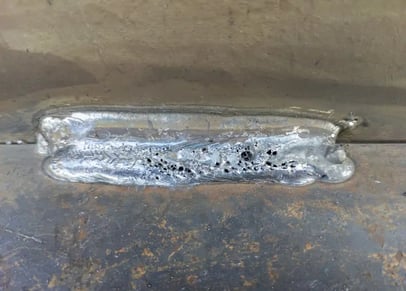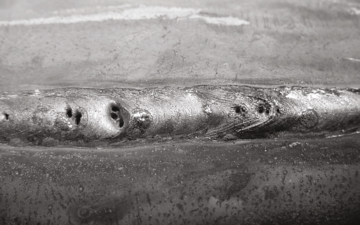Discover What is Porosity in Welding and Its Impact on Architectural Stability
Discover What is Porosity in Welding and Its Impact on Architectural Stability
Blog Article
Understanding Porosity in Welding: Exploring Causes, Effects, and Avoidance Methods
Porosity in welding is a relentless challenge that can considerably affect the quality and honesty of welds. As specialists in the welding market are cognizant, comprehending the causes, results, and avoidance methods connected to porosity is essential for accomplishing durable and reliable welds. By diving into the source of porosity, examining its detrimental results on weld high quality, and checking out reliable prevention approaches, welders can enhance their understanding and skills to create high-grade welds consistently. The detailed interplay of elements adding to porosity calls for an extensive understanding and a proactive technique to ensure successful welding results.
Usual Reasons of Porosity
Contamination, in the form of dirt, oil, or corrosion on the welding surface, creates gas pockets when heated, leading to porosity in the weld. Improper securing takes place when the shielding gas, typically used in processes like MIG and TIG welding, is incapable to totally shield the molten weld swimming pool from reacting with the bordering air, resulting in gas entrapment and subsequent porosity. Additionally, insufficient gas protection, usually due to inaccurate flow prices or nozzle positioning, can leave components of the weld vulnerable, enabling porosity to develop.
Impacts on Weld Top Quality
The existence of porosity in a weld can substantially compromise the total quality and stability of the bonded joint. Porosity within a weld produces spaces or cavities that weaken the framework, making it more at risk to splitting, deterioration, and mechanical failure. These voids act as stress concentrators, lowering the load-bearing capacity of the weld and boosting the probability of early failure under used anxiety. In addition, porosity can also work as potential sites for hydrogen entrapment, additional aggravating the degradation of the weld's mechanical residential properties.
Additionally, porosity can prevent the efficiency of non-destructive testing (NDT) strategies, making it challenging to find other problems or interruptions within the weld. This can bring about significant safety worries, particularly in important applications where the architectural stability of the bonded parts is vital.

Avoidance Techniques Overview
Provided the detrimental impact of porosity on weld top quality, reliable prevention methods are vital to preserving the architectural integrity of bonded joints. Among the key prevention strategies is extensive cleansing of the base products before welding. Pollutants such as oil, grease, corrosion, and dampness can add to porosity, so guaranteeing a tidy work surface area is vital. Correct storage of welding consumables in dry conditions is additionally critical to stop dampness absorption, click here to read which can lead to gas entrapment throughout welding. In addition, selecting the proper welding criteria, such as voltage, present, and take a trip speed, can assist lessen the risk of porosity development. Making sure ample shielding gas flow and protection is an additional important prevention method, as not enough gas protection can lead to atmospheric contamination and porosity. Lastly, appropriate welder training and certification are vital for implementing precautionary measures effectively and consistently. By including these prevention strategies right into welding methods, the event of porosity can be substantially reduced, causing more powerful and more trusted welded joints.
Relevance of Appropriate Protecting
Proper protecting in welding plays a vital duty in preventing climatic contamination and guaranteeing the honesty of bonded joints. Securing gases, such as argon, helium, or a blend of both, are typically utilized to protect the weld pool from responding with aspects airborne like oxygen and nitrogen. When these responsive aspects enter into call with the warm weld pool, they can trigger porosity, leading to weak welds with reduced mechanical residential or commercial properties.

Inadequate securing can lead to different defects like porosity, spatter, and oxidation, jeopardizing the structural honesty of the bonded joint. As a result, adhering to appropriate securing techniques is important to generate high-grade welds with marginal issues and guarantee the long life and reliability of the welded elements (What is Porosity).
Surveillance and Control Methods
Just how can welders successfully check and control the welding process to make certain ideal results and protect against defects my website like porosity? By continually monitoring these variables, welders can determine discrepancies from the ideal problems and make prompt changes to avoid porosity development.

Additionally, carrying out correct training programs for welders is necessary for checking and managing the welding process successfully. What is Porosity. Educating welders on the significance of maintaining consistent criteria, such as correct gas shielding and travel rate, can aid stop porosity problems. Routine assessments and qualifications can likewise make sure that welders excel in tracking and regulating welding procedures
In addition, the official site use of automated welding systems can boost monitoring and control capabilities. These systems can specifically manage welding criteria, lowering the chance of human error and making certain constant weld high quality. By combining innovative surveillance innovations, training programs, and automated systems, welders can effectively monitor and manage the welding process to reduce porosity defects and accomplish top quality welds.
Verdict

Report this page